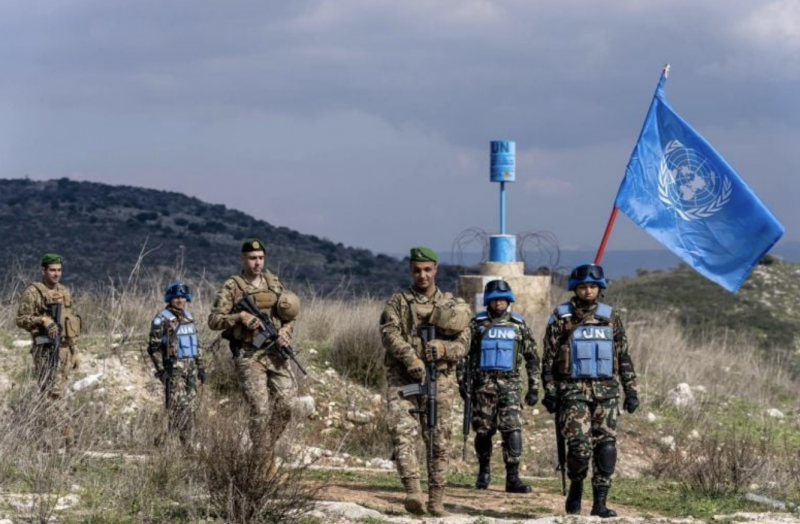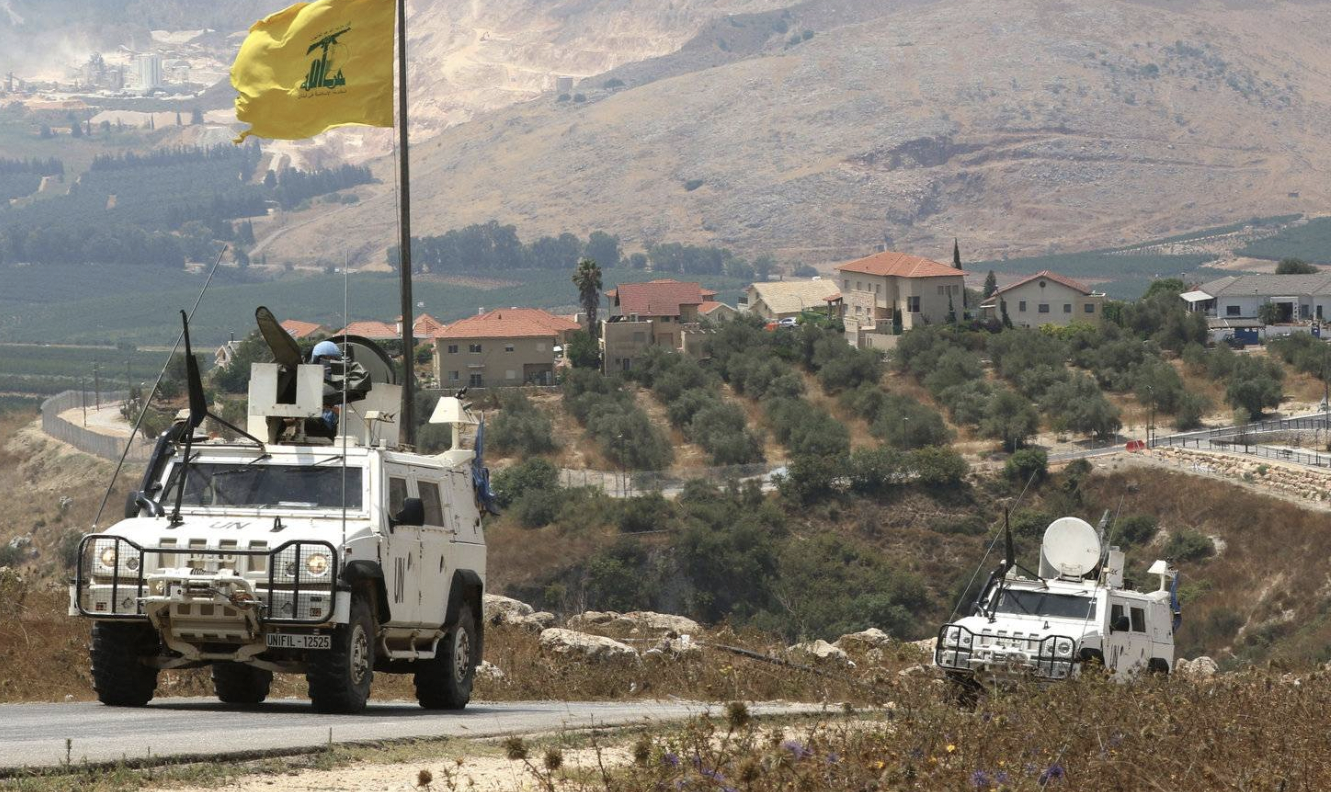
Blue Helmets and Lebanese Army soldiers along the southern border. (Credit: Photo archives/Finul)
Has Israel adhered to Resolution 1701?
In his Wednesday speech, Hezbollah Secretary General Hassan Nasrallah underscored to the international community, eager to see the UN resolution — designed to conclusively end the 2006 war — rigorously implemented, and that his group is not the sole non-compliant party.
This assertion predates the group’s decision to designate southern Lebanon as a front to support Hamas in its operation against Israel, despite the “total cessation of hostilities” stipulated in the resolution.
In reality, between Aug. 11, 2006 and Oct. 8, 2023, neither Hezbollah nor Israel genuinely adhered to the provisions of this resolution. Instead, the two parties replaced it with a “modus vivendi,” which crumbled following the Hamas Oct. 7 attack.
UN ‘Chapter VI and a half’
On July 12, 2006, Hezbollah attacked northern Israel, resulting in the death of eight soldiers and the capture of two others.
In response, Israel launched a series of intense shelling on critical sites in Lebanon, resulting in the death of many civilians.
In an effort to quell the escalating conflict, France and the United States intervened in New York, engaging in negotiations with Beirut and Tel Aviv to formulate the terms of a Security Council resolution facilitating a ceasefire.
The culmination of these efforts was Resolution 1701, emerging after over a month of fierce fighting and a toll of more than a thousand lives.
Now, 18 years later, this resolution returns to prominence as the Tel Aviv government endeavors to secure the safety of its citizens who have fled northern towns.
The essence of Resolution 1701, however, lies in its objective to relocate Hezbollah away from the border region, aiming to curtail its capacity to carry out attacks against Israel.
Article 8 of the resolution outlines the creation of a buffer zone, free of any armed personnel, assets and weapons between the Blue Line and the Litani River, excluding those deployed by the Lebanese government and the United Nations Interim Force in Lebanon (UNIFIL).
Within this framework, Beirut is tasked with mobilizing approximately 15,000 soldiers from the Lebanese army. Together with the peacekeeping forces,they are entrusted with the responsibility of maintaining stability in the border region and preventing any resurgence of hostilities.
Going beyond this, the Security Council urges Beirut to extend its sovereignty over the entirety of its territory, ensuring that no authority other than that of the Lebanese government is exercised. In essence, this implies the disarmament of Hezbollah.
However, neither Hezbollah nor the Lebanese state have fulfilled these commitments, despite Hezbollah’s fighters maintaining a low profile in the buffer zone since 2006.
“To describe this situation, it is often said that what you can’t see doesn’t exist,” said former minister Tarek Mitri, a participant in the New York negotiations in August 2006 that led to the adoption of Resolution 1701.
While the Security Council resolution is theoretically binding, there exists no concrete mechanism for punishing violations. This is compounded by the fact that Resolution 1701 was adopted under UN Chapter VI, emphasizing the peaceful resolution of conflicts, rather than Chapter VII, as advocated by Washington, Paris and Tel Aviv at the time.
Chapter VII allows the Security Council to take any action it deems necessary to maintain or restore international peace and security, whether by air, sea or land forces.
“During the negotiations, the Lebanese government’s position was that the resolution should not be placed under Chapter VII,” Mitri said. “It was a priority.”
Hezbollah went so far as to convey that if the Security Council insisted on using this chapter, it would treat the UN peacekeepers as “a foreign occupying force.”
Ultimately, Hezbollah, and by extension, the Lebanese government, consented to a compromise solution: Placing the resolution under Chapter VI but employing the resolute language typically associated with texts under Chapter VII.
In Lebanese political circles, this compromise is often ridiculed, referring to it as “Chapter VI and a half.”
These measures, however, fall short of ensuring compliance with the resolution.
Despite explicit assertions in international texts highlighting UNIFIL’s independence, in practice, it functions as little more than an observation force.
“All it takes is a simple demonstration by people close to Hezbollah to prevent the peacekeepers from carrying out their mission,” Mitri said.
In fact, UNIFIL cannot afford to position itself in direct confrontation with Hezbollah, which exercises dominance in the area where they are deployed, risking severe consequences.
This vulnerability was underscored in December 2022 when Irish peacekeeper Sean Rooney lost his life, and three colleagues were wounded, in an attack on their vehicle near the village of Aaqibiye in the south.
The same challenge applies to the Lebanese Army, rendering it incapable of executing the stipulations of Resolution 1701.
Deploying 15,000 soldiers south of the Litani, which constitutes over a quarter of the army’s strength, is deemed impractical without triggering a severe imbalance in other areas, as noted by a retired general.
“With a limited force numbering only a few tens of thousands, the army is tasked with ensuring security nationwide, including the porous border with Syria,” the retired army general told L’Orient-Le Jour on condition of anonymity due to the sensitivity of the issue.
“That’s without taking into account the fact that it would be suicide for the army to position itself in frontal opposition to Hezbollah,” he added.
Hezbollah only boasts superior equipment compared to the regular army, but adopting such a stance would inevitably result in numerous defections within the army, particularly among Shiite soldiers, and could even lead to war.

UNIFIL vehicles patrol southern Lebanon. (Credit: Mahmoud Zayyat/AFP)
Seven-point plan
While Israel often highlights violations of Resolution 1701 on the Lebanese side in its media, it appeared — until Oct. 8 — to tolerate the status quo.
“In the end, the border was calm most of the time,” said Mitri.
Israel, however, has not upheld its end of the bargain either.
While the fourth article of the resolution reaffirms the Security Council’s strong support for strict respect for the Blue Line, the Israelis have never truly respected the border between the two countries, consistently violating Lebanese airspace.
Long before the October war, they regularly conducted reconnaissance operations over Lebanon.
After 2011, these overflights intensified, with Israel using Lebanese airspace to bomb pro-Iranian targets in Syria.
There are also territorial violations.
The most recent example is Tel Aviv’s decision last July to annex the northern part of the cross-border village of Ghajar, cutting off its access to the rest of Lebanese territory, all while the international community remained silent.
Another aspect of the 1701 agreement that has been overlooked is the fate of Shebaa farms.
While this small piece of the Golan occupied by Israel is considered Syrian in the eyes of the international community, Lebanon lays claim to it.
During the 2006 negotiations, Beirut succeeded in having this issue included in Resolution 1701, as the Shebaa farms are mentioned twice in the resolution (preamble and article 10).
More specifically, the Security Council is urging the implementation of the “seven points,” a reference to the proposal formulated at the end of July 2006 in Rome by then Lebanese Prime Minister Fouad Siniora.
This plan calls for an Israeli withdrawal from the disputed zone in favor of a UN force for a transitional period, while a definitive solution is negotiated, particularly between Damascus and Beirut.
Article 10 outlines the delimitation of the international borders between Lebanon and its two neighbors.
This provision has remained a dead letter, much to the delight of Hezbollah, which refuses to disarm, arguing that part of Lebanese territory is still under occupation.
In October 2022, Lebanon and Israel inked an agreement delineating their maritime border.
Since the Israel-Hamas war broke out, Amos Hochstein, the American envoy who negotiated this deal, has been diligently working to reach a similar agreement concerning the land border, contingent on Hezbollah adhering to the principle of a “buffer zone” south of the Litani River. Other Arab and Western diplomats are also intensifying their efforts to avert a catastrophic escalation.
Will these endeavors yield results? The most probable scenario, according to Mitri, is a formula akin to the pre-war status quo — a situation that suited the principal parties involved just fine.
This article was originally published in L'Orient-Le Jour. Translated by Sahar Ghoussoub.